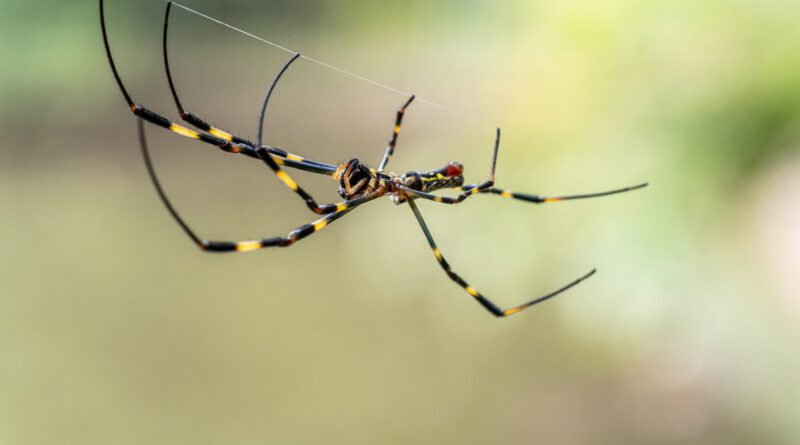Large spiders are rapidly spreading in the U.S. They’re not after you.

A vividly-colored spider the size of your palm is rapidly spreading in parts of the U.S. It’s best we learn to become friendly neighbors.
The Joro spider, which like many invasive species probably hitched a ride across the sea in a shipping container, started expanding in Georgia around 2014. The descendants of those first arachnids now have a thriving U.S. population, far from their natural habitat in East Asia. They’ve already moved into neighboring states in the Southeast and are expected to migrate north and colonize parts of the East Coast as they can withstand some cold climes. We’ll see how far they go.
Crucially, the arachnid’s colonization is still new. So scientists’ grasp of the impacts Joros will have on the environment — good, bad, or neutral — is uncertain and evolving. But biologists are progressively learning more about the recently-arrived species, which build impressive, strong webs. Though Joros never posed much danger to us — they aren’t interested in people, and would have a very hard time harming us with tiny fangs and weak venom — new research that tested their reaction to disturbance provides more evidence they’re a non-aggressive, perhaps even shy, species.
“It turns out they are really, really shy. They are remarkably shy,” Andy Davis, an ecologist at the University of Georgia and an author of the new research published in the science journal arthropoda, told Mashable.
“They are remarkably shy.”
This shyness might mean they’re unlikely to attack and outcompete native U.S. spiders, though the evidence is still far from certain. But what is clear is they’re not coming for us, or our pets.
“Joro spiders are pretty docile things and this reinforces that,” David Coyle, an assistant professor of forest health and invasive species at Clemson University who had no role in the study, told Mashable. “It reinforces the fact that most animals out there are not out to get you.”
How threatening are Joro spiders?
The researchers wanted to know how aggressive Joros are compared with other spiders. It happens there’s a well-established way to research this in a lab: blowing air on spiders and seeing how they react. The scientists (harmlessly) blew puffs of air on 16 Joro spiders and over 30 individuals of other species — as well as analyzing nearly 400 previous observations from other arachnid tests. The results were stark. Native spiders, like the marbled orb weavers, froze for a minute or two. But the Joros froze for over an hour.
“It was ridiculous,” Davis said.
(What’s more, a spider closely related to the Joro, the golden silk spider, which occurs naturally in the U.S., also remained frozen for a long time. This group of spiders might share this timidity.)
“It was ridiculous.”
The other author of the paper, Amitesh Anerao, who is an undergraduate at the University of Georgia, was the diligent researcher patiently waiting for the frozen Joros to move. Indeed, the spiders are invasive, but the evidence shows they’re not nearly aggressive.
“Most people think ‘invasive’ and ‘aggressive’ are synonymous,” Anerao said in a statement. “People were freaking out about the Joro spiders at first, but maybe this paper can help calm people down.”

Coexisting with Joro spiders
It’s not possible to stop the Joro from spreading.
“It’s a good idea to get used to them,” said Clemson’s Coyle. “I don’t see any scenario where they’re going away. They’re a part of the ecosystem.”
The spiders are expanding naturally, and almost certainly hitching rides on cars and trucks, too. That’s how an isolated spider almost certainly made it to Oklahoma. There have already been other isolated reports in Maryland and West Virginia, too.
In some places, their strong, giant webs spanning many feet will be conspicuous, if not dominant. Davis has seen them in his backyard. Some people will run into these tough webs, and discover just how robust they are. “It’s stopped me in my tracks,” Robert Furey, a spider expert at Harrisburg University of Science and Technology, told Mashable last year.
“It’s a good idea to get used to them.”
Now that they’ve landed in the U.S., a number of factors may drive the Joros’ rapid expansion. Although they clearly freeze when disturbed, they are unusually tolerant of human landscapes, Davis said, noting he’s seen them on gas station pumps and streetlights. They might also be outbreeding other species, with egg sacs brimming with some 1,000 eggs each. It also might be that predators such as birds and reptiles in the U.S. haven’t caught on that Joros are a new protein-rich prey.

More observation and research will reveal the effects these spiders are having out there. “Sure, there could be harm,” said Davis. “But there can be a benefit. The Joros might end up being a snack for somebody.”
One thing is for sure: We don’t need to fear them, even if we find some spiders or insects unsettling.
Want more science and tech news delivered straight to your inbox? Sign up for Mashable’s Light Speed newsletter today.
If one appears on your porch and you don’t like it, you can move it with a broom or broom handle, suggested Coyle. If you’re so inclined, Davis suggested even using a Joro in your backyard or front porch to observe, visit, and learn more about spiders. After all, they’re a fascinating part of our world. “It’s not aggressive. You can get to know your local spider,” he said.
Either way, it’s time to accept our new neighbors.
“We need to live with them,” Davis said.
